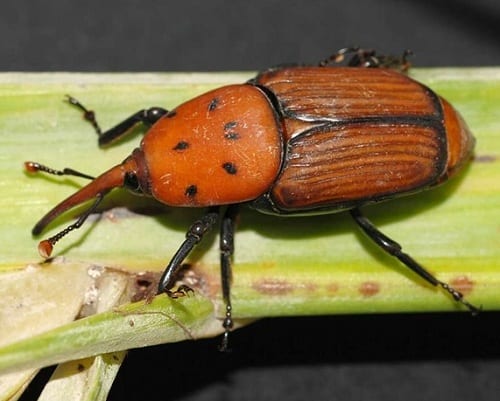THOUGH the first mention of the red palm weevil comes from India in 1891, it is thought to have originated in south-east Asia, before spreading to Europe, the Middle East, north Africa, the Americas, the Caribbean and Australasia.
First discovered in Spain in 1994, the weevil – a species of snout-nosed beetle – is only a few centimeters in length, yet it has become seen as the single greatest threat to palm trees in the world.
Females can lay between 200 and 300 eggs inside a palm. After three or four days the eggs hatch into grubs, which bore into the palm tree by eating the soft tissue, killing it from within. After a few months the weevil then enters into a pupation period, eventually emerging as an adult beetle and starting the whole process again.
Since the 1990s, the palm weevil is thought to have killed around 20,000 palm trees in Andalucia alone.
The trade in young palm trees has led to an explosion in the worldwide weevil population, since the beetles are transported inside their favourite food supply, before being left to their own devices, usually in an area with yet more fresh food.
The damage done by these insects means that stopping them is big business – but it has proved harder than you may expect, with weevils almost impossible to stop.
One solution is to inject insecticides directly into the trunk of a stricken tree, killing the weevil on contact.
However this solution relies on the ability to spot the beetles’ presence early.
Weevils spend their entire life cycles inside a palm tree, and by the time any damage is visible on the outside it is likely that the palm is already dead.
Malaga City Council has come up with a more unusual solution – turned to a team of dogs for help, training them to sniff the beetles out so that they can be dealt with before they gain a foothold.
Their newest recruit, Virus – a Belgian Shepherd – is expected to graduate soon. The final stage of his training is a lesson in how to stand on top of platforms, which allow him to sniff the top of palms.
Another possible solution comes from The University of Cordoba which is researching the effectiveness of different types of fungus, which are toxic to the weevil, though it is not yet clear whether it is suitable for widespread use.
Whatever the answer, something needs to be done about the weevil.
Click here to read more News from The Olive Press.









An old gardner’s advice:
Every 15 days pour a mixture of washing liquid+olive oil+water through the heart of the palm!
I,ve followed this procedure the last 6 months…..time will tell.
@ Shahla. We’ve done this for the last ten years but alas, one of ours succumbed last year. The others for the moment, seem ok.